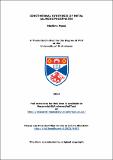Ionothermal synthesis of metal aluminophosphates
Abstract
The aim of this thesis was to synthesise CoAPO-34 and FeAPO-34 using ionothermal synthesis
in the presence of organic amines. Using this method provides an alternative route to prepare
such materials under low pressure instead of the higher pressure associated with hydrothermal
or solvothermal synthesis. Both materials have chabazite (CHA) topology and they are known to
act as catalysts.
CoAPO-34 was ionothermally prepared using 1-ethyl-3-methylimidazolium bromide (EMIMBr) in
presence of 1, 6-hexadiamine (HDA). This study has found that when the synthesis was carried
out without HDA, AlPO-11 was preferentially obtained instead of CoAPO-34. Broad line signals
which appear between 2000 to 5000 ppm in both spin-echo ³¹P NMR spectra of as-synthesised
and calcined CoAPO-34 confirm that the Co²⁺ ions have been successfully incorporated within
the framework of the material.
FeAPO-34 was synthesised under ionothermal conditions using 1-ethyl-3-methylimidazolium
chloride in the presence of ethylenediamine (EDA). In the absence of EDA, the synthesis has
produced AlPO-34 instead of FeAPO-34. Broad line signals that appear between 1000 to
14000 ppm in spin-echo ³¹P NMR spectra of both as-synthesised and calcined FeAPO-34 are
direct evidence of isomorphous substitution of framework aluminum by Fe(II) or Fe(III).
Another aim of this study was to explore the ionothermal synthesis of copper containing
aluminophoshate of DNL-1 (Cu/DNL-1). This material was attractive to explore because it
contains 20 ring extra-large pores and Cu(I) species in the channels of the framework,
potentially giving material the ability to simultaneous store NO and to generate NO from NO₂⁻ anions.
Cu/DNL-1 was successfully prepared under ionothermal conditions using EMIMBr and HDA.
Without HDA in the synthesis, AlPO-11 was obtained. In this material, copper ions were not
incorporated in the Cu/DNL-1 skeleton framework. This was confirmed by absence of broadline
signal at >500 ppm in spin-echo ³¹P NMR spectrum of the sample. The copper ions are
expected to be present as extra-framework cations. Extra-framework Cu(I) species that were
formed by high temperature calcination of Cu/DNL-1 are active to produce NO from NO₂⁻. Therefore, the calcined Cu/DNL-1 can be used to simultaneously store and produce NO from
nitrite. This has the potential to significantly extend the lifetime of gas delivery in the material to
prevent thrombus formation.
Type
Thesis, PhD Doctor of Philosophy
Collections
Items in the St Andrews Research Repository are protected by copyright, with all rights reserved, unless otherwise indicated.

